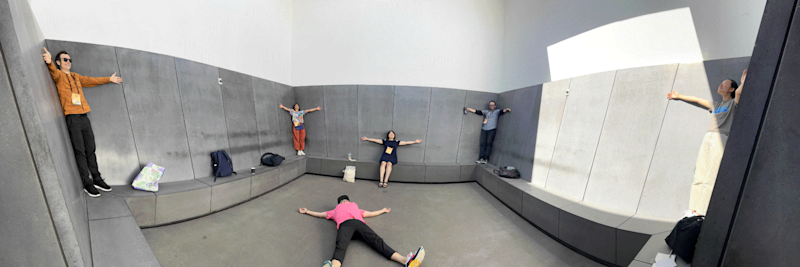Notes on Blocks
On Connection
8/17/2022
Leslie Liu

Here is a photo of one of my favorite moments this summer. This was in Minneapolis during Eyeo, a design-art-tech-all-things-in-between festival. It was Friday, the last day of the conference, and by some way or another a dozen of us had stopped by James Turrell's Sky Pesher.
In my diary I wrote,
a sidenote — I like how a handful of us [festival attendees] have gathered hereI’m into pilgrimages lately
What was so joyful about this moment was the way we each embarked on our private journeys to the art piece, and serendipitously realized, ah, there you are too. A friend aligned themself with a corner of the space, arms outstretched, feeling the sun and the sky. Soon six, seven of us had aligned ourselves with the other corners, forming what was later described as a portal, opening up to some dimension beyond.
This photo of us is important to me because it captures quite nicely what I’d like to explore and catalog in this Are.na channel, — connect.
— connect has accidental origins. A friend and I were pushing the auto-suggested replies function in LinkedIn Messaging to see whether we could cycle through the six common story arcs through such sparse, generic, aggressively upbeat officespeak. There was something compelling about the way the depth of our human experience was distilled into these rather bland, agreeable smiley emoji. Was this how we wanted our computers to regard human relationships? Communicating with each other through the most extreme, bare-bones version of the site reminded me of other online exchanges where people either have to surrender to the limitations of the platform, or find ways to work around gaps in conversation.
— connect has grown to include perspectives on relationships between people as well as their personal relationships with the technology they use to communicate so intimately. — connect harbors many pieces of childhood writings and memories, pulling from personal moments nostalgic to me, in order to imagine what kinds of (digitally-mediated) interactions and encounters we might seek out in pursuit of that ambiguous feeling of cosmic love, of love for one another. Drawing from Audre Lorde’s definition of the erotic, the particular shade of love this channel holds on to is that feeling of recognition when you’re with people — when you’re in good company — and their presence is enough to instill in you a sense of joy and vitality.
The various homes the Bird family tries out in P.D. Eastman’s The Best Nest feel like different forms of conversations to me. Do you ever catch yourself appreciating the way a conversation takes shape when you’re in the middle of it all? How do you settle down (even if it’s temporary) and be present with the other person/people?
This parachute game from childhood has been personally hugely influential. The way someone at the 2021 Computer Mouse Conference described it is perfect: “i miss the parachutes. what a weird time that was! who invented that and what for?! the bit where you run under and meet ppl in the middle was always so special.”
This high five area on Figma is a helpful example of finding connection and joy online within limited platforms and interfaces. If your heart is willing, there is a way to use (or misuse) tools to foster the kinds of connection you so desire.
Humans of VR is a YouTube series where strangers talk about deeply personal things in virtual reality, from religious experiences to learning American Sign Language. The series has helped me rethink the otherwise heavily memed space of VRChat. What kinds of vulnerability might certain platforms or social media encourage, and what kinds of expression do they limit?
How would it feel to treat a one-time interaction with someone as if they were an old friend? What boundaries get lost along the way between the online and the offline, between real-time communication and asynchronous messaging?
This piece came out of one of our “Are.na Walkthroughs,” during which four people take us through a particular channel and some of the things they’ve collected in it.
Leslie Liu is a designer dreaming of stuff that helps us reconsider intimacy and connection.
Are.na Blog
Learn about how people use Are.na to do work and pursue personal projects through case studies, interviews, and highlights.
See MoreYou can also get our blog posts via email